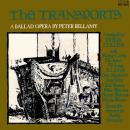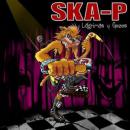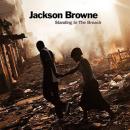Come all you young fellows that carry a gun,
I'll have you come home by the light of the sun.
For young Jimmy was a fowler, and a-fowling alone,
When he shot his own true love in the room of a swan.
As Polly went out in a shower of hail,
She crept unto the bushes herself to conceal
With her apron thrown over her, and he took her for a swan,
With a shot in the dark he killed Polly his own.
Then home rushed young Jimmy with his dog and his gun,
Crying, “Uncle, dear uncle, have you heard what I've done?
O cursed be that old gunsmith that made my old gun,
For I've shot my own true love in the room of a swan!”
Then out rushed bold uncle with his locks hanging grey,
Crying, “Jimmy, dear Jimmy, don't you run away.
O don't you leave your own country till your trial do come on,
For they never would hang you for shooting a swan.”
Now the girls of this country, they're all glad we know,
To see Polly Vaughan a-lying so low.
You could gather them into a mountain, you could plant them in a row,
And her beauty'd shine among them like a fountain of snow.
Well, in six weeks time the assizes were on
And Polly did appear in the form of a swan,
Crying, “Uncle, dearest uncle, let Jimmy go clear,
For he never should be hung for shooting his dear.”
I'll have you come home by the light of the sun.
For young Jimmy was a fowler, and a-fowling alone,
When he shot his own true love in the room of a swan.
As Polly went out in a shower of hail,
She crept unto the bushes herself to conceal
With her apron thrown over her, and he took her for a swan,
With a shot in the dark he killed Polly his own.
Then home rushed young Jimmy with his dog and his gun,
Crying, “Uncle, dear uncle, have you heard what I've done?
O cursed be that old gunsmith that made my old gun,
For I've shot my own true love in the room of a swan!”
Then out rushed bold uncle with his locks hanging grey,
Crying, “Jimmy, dear Jimmy, don't you run away.
O don't you leave your own country till your trial do come on,
For they never would hang you for shooting a swan.”
Now the girls of this country, they're all glad we know,
To see Polly Vaughan a-lying so low.
You could gather them into a mountain, you could plant them in a row,
And her beauty'd shine among them like a fountain of snow.
Well, in six weeks time the assizes were on
And Polly did appear in the form of a swan,
Crying, “Uncle, dearest uncle, let Jimmy go clear,
For he never should be hung for shooting his dear.”
Contributed by Bernart Bartleby - 2016/11/18 - 22:22
Alla ballata ho dedicato in Terre Celtiche Blog quattro puntate. Nella parte introduttiva ho analizzato la storia con tutte le sue implicazioni di ballata soprannaturale (riflessioni sulla donna-cigno, sul tema della donna-animale sacrificale nella tematica stupro-incesto, il mito greco di Cefalo e Procri).

Molly B(r)own o Polly Vaughan: INTRO
LA VERSIONE IRLANDESE: Molly Ban
LA VERSIONE INGLESE: Polly Vaughan
LA VERSIONE AMERICANA: Polly Vaughn
con esempi, testi e traduzioni
La ballata Molly Bawn/Brown/Ban non è presente nella raccolta del professor Child e quindi alcuni studiosi mettono in dubbio la sua antichità, tuttavia Jennifer O’Connor ha pubblicato sul Canadian Journal for Traditional Music (1986) un esaustivo articolo a proposito dal titolo “The Irish Origins and Variations of the Ballad “Molly Brown” al quale si rimanda per l’approfondimento.

Molly Bawn o Polly Vaughan, la donna-cigno? | Terre Celtiche Blog
La canzone ha molti titoli simili per assonanze vocali a "Polly Vaughn" o "Molly Ban" ma è anche intitolata come "The Fowler" o "The Shooting of His Dear" : la storia è molto triste perchè il protagonista uccide incidentalmente la sua innamorata; di sera mentre è a caccia, vede qualcosa di bianco tra i cespugli e spara, credendo si tratti di un cigno. Avvicinandosi alla preda si accorge di aver ucciso la propria fidanzata che si era riparata
Molly B(r)own o Polly Vaughan: INTRO
LA VERSIONE IRLANDESE: Molly Ban
LA VERSIONE INGLESE: Polly Vaughan
LA VERSIONE AMERICANA: Polly Vaughn
con esempi, testi e traduzioni
La ballata Molly Bawn/Brown/Ban non è presente nella raccolta del professor Child e quindi alcuni studiosi mettono in dubbio la sua antichità, tuttavia Jennifer O’Connor ha pubblicato sul Canadian Journal for Traditional Music (1986) un esaustivo articolo a proposito dal titolo “The Irish Origins and Variations of the Ballad “Molly Brown” al quale si rimanda per l’approfondimento.
Cattia Salto - 2021/3/27 - 15:03
×
![]()
Note for non-Italian users: Sorry, though the interface of this website is translated into English, most commentaries and biographies are in Italian and/or in other languages like French, German, Spanish, Russian etc.









Una canzone popolare irlandese già ben conosciuta – ma disdegnata - da Robert Jamieson (1772 – 1844), antiquario scozzese che nel 1806 curò l'edizione della raccolta “Popular Ballads And Songs From Tradition, Manuscripts And Scarce Editions With Translations Of Similar Pieces From The Ancient Danish Language”.
Le versioni e gli interpreti del brano sono moltissimi, sicchè ho deciso di proporre qui il testo di una delle prime registrazioni, quella di A. L. Lloyd risalente al 1951, come trovata su English Folk Music
Dalla raccolta curata da Peter Kennedy ed Alan Lomax intitolata “The World Library of Folk and Primitive Music: England”, Columbia Masterworks, USA, 1955.
Il tema della donna magica che si trasforma in animale, una bianca cerva, come nella Complainte de la blanche biche, o, come in questo caso, un bianco cigno – e si noti però l'identico candore e, già nel titolo, l'assonanza tra “dear” e “deer” - è un tema di origine addirittura celtica.
Nello specifico però il giovane “poacher”, cacciatore di frodo, uccide per errore la sua bella scambiandola per un cigno perchè lei, colta dal temporale sulla strada di casa, per ripararsi dalla pioggia, si è avvolta in una bianca veste. Ma la dimensione del magico viene comunque recuperata nel prosieguo della vicenda, quando la candida bellezza di Polly viene descritta quasi come soprannaturale, una “fontana di neve”, invidiata da tutte le altre ragazze del villaggio, e soprattutto quando il fantasma di Polly compare nell'udienza per scagionare con la sua testimonianza Jimmy, il suo fidanzato ed assassino, che davvero l'ha uccisa per un tragico errore ma rischiava comunque la forca.
Si potrebbe poi aggiungere – senza scomodare i celti e dando alla triste vicenda di Jimmy e di Polly un'interpretazione più prosaica che la trasporterebbe in tempi più recenti – che è nella seconda metà del 700, a partire dalla guerra dei Sette Anni e dalla Rivoluzione americana, che il nonno del fucile moderno cominciò ad avere una grande diffusione sicchè, in guerra come in pace, il numero di morti cominciò a registrare un incremento costante e, ancora oggi, inarrestabile...